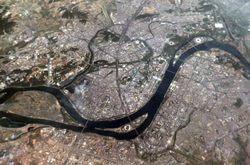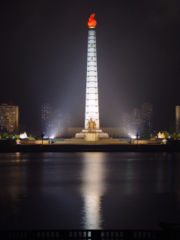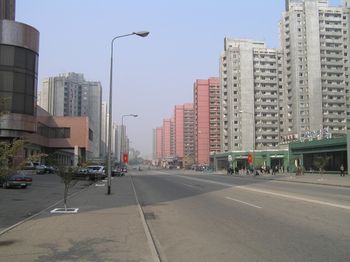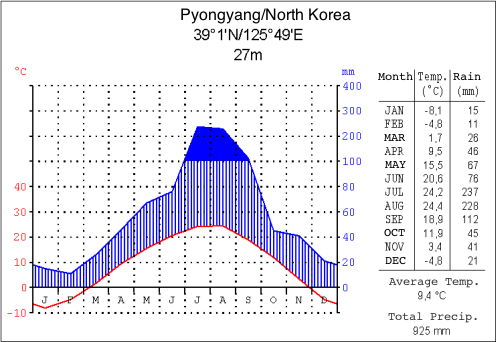Pyongyang
2007 Schools Wikipedia Selection. Related subjects: Geography of Asia
- "Heijo" redirects here: for the ancient capital of Japan, see Heijō Palace; For the graphic novel by Guy Delisle, see Pyongyang (comic).
| P'yŏngyang Directly Governed City | |
|---|---|
| Korean name | |
| McCune-Reischauer | P'yŏngyang Chikhalsi |
| Revised Romanization | Pyeongyang Jikhalsi |
| Hangul | 평양 직할시 |
| Hanja | 平壤直轄市 |
| Short name | P'yŏngyang (Pyeongyang; 평양) |
| Statistics | |
| Population | 2,741,260 ( 1993) |
| Area | 3,194 km² |
| Government | Directly Governed City, Capital of North Korea |
| Administrative divisions | 19 wards (kuyŏk), 4 counties (kun) |
| Region | Kwansŏ |
| Dialect | P'yŏngan |
| Location map | |
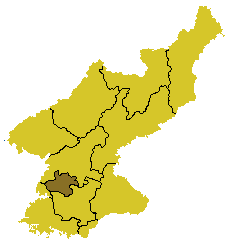 |
|
Pyongyang is the capital city of North Korea, located on the Taedong River, at (39.0333, 125.75). The official population of the city is not disclosed; given as 2,741,260 in 1993, it was reported as 2.5 and 3.8 million in 2002 and 2003 by Chosen Soren, a pro-North Korean organization.
The city was split from the South P'yŏngan province in 1946. It is administered as a Directly Governed City (Chikhalsi), on the same level as provincial governments, not a Special City (Teukbyeolsi) as Seoul is in South Korea. Some sources, mostly older and South Korean, refer to P'yŏngyang as a Special City, but it has been reported that even the South Korean government adopted the Directly Governed City terminology in 1994.
History
According to legend, the city was founded in 2334 BC as Wanggŏmsŏng (왕검성; 王儉城). It became a major city under Gojoseon.
In 108 BC Han Dynasty conquered Gojoseon and the capital of the Lelang Commandery was put near Pyongyang. Lelang remained an important commercial and cultural outpost until it was destroyed by the expanding Goguryeo in 313.
Goguryeo moved its capital here in 427. The Tang dynasty and Silla allied and defeated Goguryeo in 668. In 676, it was taken by Silla but left in the border between Silla and Balhae until the Goryeo dynasty, when the city was revived as Sŏgyŏng (서경; 西京; "Western Capital") although never actually a capital of Goryeo. It was the provincial capital of the P'yŏngan Province during the Joseon dynasty, becoming provincial capital of South P'yŏngan Province from 1896 and through the period of Japanese rule.
In 1945, Japanese rule ended and it was occupied by Soviet forces, and became the temporary capital of the Democratic People's Republic of Korea at its establishment in 1948 while it aimed to recapture its official capital at that time of Seoul. It was severely damaged in the Korean War, during which it was briefly occupied by South Korean forces. After the war, the city was quickly rebuilt with Soviet help, with many buildings built in Stalinist architecture.
Historic names
One of its many historic names is Ryugyŏng (류경; 柳京), or "capital of willows", as willow trees have always been numerous throughout the city's history, and many poems written about these willows. Even today, Pyongyang has numerous willow trees planted everywhere, and many buildings and places have "Ryugyŏng" in their names, the most notable of all being its uncompleted Ryugyŏng Hotel. Its other historic names include Kisŏng, Hwangsŏng, Rangrang, Sŏgyŏng, Sŏdo, Hogyŏng, Changan, etc. During the Japanese occupation, it was also known as Heijō, which is simply the Japanese reading of the Chinese characters 平壌 the name Pyongyang consists of.
Administrative divisions
P'yŏngyang is divided into 19 wards ("Kuyŏk" or "guyŏk") and 4 counties ("Kun" or "gun").
- Chung-guyŏk (중구역; 中區域)
- P'yŏngch'ŏn-guyŏk (평천구역; 平川區域)
- Pot'onggang-guyŏk (보통강구역; 普通江區域)
- Moranbong-guyŏk (모란봉구역; 牡丹峰區域)
- Sŏsŏng-guyŏk (서성구역; 西城區域)
- Sŏn'gyo-guyŏk (선교구역; 船橋區域)
- Tongdaewŏn-guyŏk (동대원구역; 東大院區域)
- Taedonggang-guyŏk (대동강구역; 大同江區域)
- Sadong-guyŏk (사동구역; 寺洞區域)
- Taesŏng-guyŏk (대성구역; 大城區域)
- Man'gyŏngdae-guyŏk (만경대구역; 萬景台區域)
- Hyŏngjesan-guyŏk (형제산구역; 兄弟山區域)
- Ryongsŏng-guyŏk (룡성구역; 龍城區域)
- Samsŏk-guyŏk (삼석구역; 三石區域)
- Sŭngho-guyŏk (승호구역; 勝湖區域)
- Ryŏkp'o-guyŏk (력포구역; 力浦區域)
- Rakrang-guyŏk (락랑구역; 樂浪區域)
- Sunan-guyŏk (순안구역; 順安區域)
- Ŭnjŏng-guyŏk (은정구역; 恩情區域)
- Kangnam-gun (강남군; 江南郡)
- Chunghwa-gun (중화군; 中和郡)
- Sangwŏn-gun (상원군; 祥原郡)
- Kangdong-gun (강동군; 江東郡)
Landmarks
The capital has been completely rebuilt since the Korean War ( 1950– 1953). It is designed with wide avenues, imposing monuments, and monolithic buildings. The tallest structure in the city is the uncompleted 1,082 foot (330 m) Ryugyŏng Hotel. This hotel has 105 floors, encloses 3.9 million square feet (360,000 m²) of floor space, and was planned to be topped by seven revolving restaurants. However, construction has been stalled since the early 1990s and the building stands as an empty shell.
Some notable landmarks in the city include the Arch of Triumph (a larger replica of Paris's Arc de Triomphe), the reputed birthplace of Kim Il Sung at Mangyongdae Hill, Juche Tower, and two of the world's largest stadiums ( Kim Il Sung Stadium and Rungnado May Day Stadium). Pyongyang TV Tower is a minor landmark.
Transportation
Pyŏngyang has a two-line underground metro system which has a length of 22.5 km. There is also a tram and trolleybus service. There are not as many private automobiles as in Western cities, although the state government operates a sizable fleet of Mercedes-Benz limousines for Party bureaucrats. Many residents walk, cycle, or use the subway because of lack of other options for transportation.
State-owned Air Koryo has scheduled flights from Sunan Capital International Airport to Beijing ( PEK), Shenyang ( SHE), Bangkok ( BKK), and Vladivostok ( VVO). There are occasional chartered flights to Macau ( MFM), Incheon ( ICN), Yangyang County ( YNY) and several Japanese cities. Air Koryo also claims scheduled service on a few domestic routes, although the accuracy of this is not known. Intermittent service to Pyongyang is also provided by a few foreign carriers, most notably Chinese.
The city also has regular international train services to Beijing and Moscow. A journey to Beijing takes about 25 hours and 25 minutes ( K27 from Beijing / K28 from Pyŏngyang, on Mondays, Wednesdays, Thursdays and Saturdays); a journey to Moscow takes 6 days.
Climate
Sister cities
 Kathmandu, Nepal
Kathmandu, Nepal
